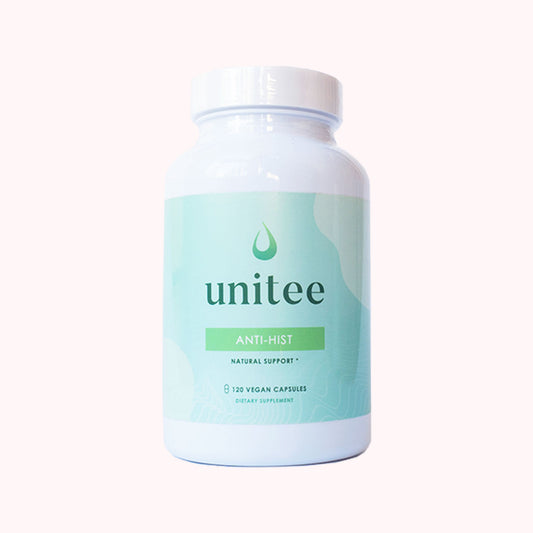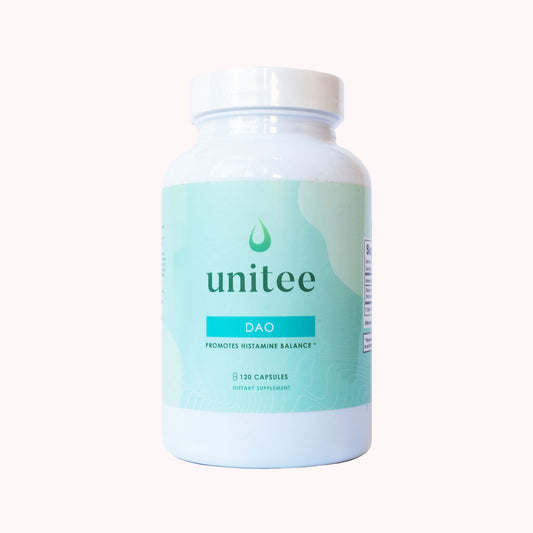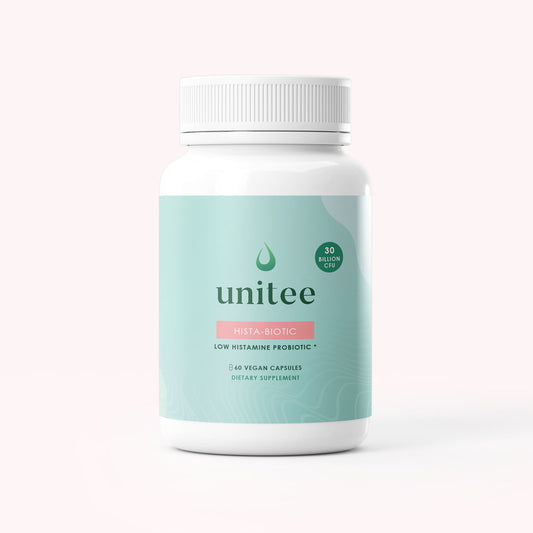Living with a histamine intolerance can be maddening. Not just frustrating… maddening.
What, with the long list of symptoms you can't quite pinpoint to anything specific you ate or did, plus the brushing off you’ve had to endure while trying to find a diagnosis for your condition.
You've probably spent hours researching on your own about how to handle your symptoms. You clearly are experiencing a problem, so why then are you still battling mainstream medicine. And why are the claims that you should simply take stronger antihistamines, continue to use your nose spray and even consider chronic cortisone use to suppress your immune reactions the only thing you're being told will help?
Of course it's completely understandable that it's probably taking a lot for you to keep at it and not give in. And it's probably weighing heavily on you whether you're able to continue to seek the appropriate treatment for your histamine intolerance and not just do what the doctor says!
What I want to do is reassure you: there is hope! And it comes in the form of education and knowledge.
When you discuss your options with your doctor, understanding what might be going on in your body and addressing those concerns in a succinct way may be just the thing that brings you closer to a resolution that works.
Let’s start with a recap of some of the basics.
Histamine Intolerance Develops Due to a Variety of Different Reasons
You already know that a variety of factors contribute to your histamine levels. How your immune system behaves, what medication you're taking, the foods and drinks you choose to consume, and even the status of your gut health can all play a role in the fluctuation of your daily histamine levels (1,2).
You've also likely come across information to confirm that the actions of histamine are most highly concentrated in the lungs, skin and gut. It's in these areas that histamine acts as a strong messenger chemical, essentially protecting these parts of the body exposed to the external environment. Because these body systems are also tightly linked to how every other body system functions, the actions of histamine in these areas can have an impact on everything that takes place throughout your entire body. It's why the symptoms of histamine intolerance can be so widespread, and cause you to have such a severe reaction in other seemingly unrelated body systems.
To tie into this concept, we have to talk about the cells that are responsible for producing and releasing histamine.
There are actually a large number of cells that make histamine. Some of these cells populate tissues in the stomach lining, lymph nodes and thymus gland. Cells that produce much smaller amounts of histamine are found in the liver, lung and brain tissues (3).
What we're interested in are two important immune cells that make and store large amounts of histamine. They are called mast cells and basophils (4). The cells are located in the tissues that are most vulnerable to the external environment, where it's highly likely that the tissues will come into contact with a foreign invader. It's at this time that these mast cells and basophils spring into action to protect us from the potential of these foreign invaders causing damage.
Ok. So you know about the cells, where histamine comes from and the tissues that are particularly susceptible to being triggered by histamine release.
What you may not know is why this causes symptoms. Isn't histamine release supposed to have a protective effect? Not seem like the body is trying to harm itself?
It all has to do with how much histamine is being produced, and whether your body is able to deal with that load or not!
What we're about to get into is information that should help you to better identify where your histamine load is coming from, and why those antihistamines you’ve been taking for so long simply don’t work as they should.
So, let's talk about histamine receptors for a minute.
The Science of Histamine Intolerance: Histamine Binding to Different Receptors
Every reaction in the body involves the need for a compound or particle, binding to its preferred receptor on a cell, eliciting a function. Histamine is no different.
Histamine is associated with four receptors, conveniently labeled H1, H2, H3 and H4. They are spread throughout the body depending on what histamine reaction is needed, and where the histamine release is taking place (5). When histamine locks into these receptors, it will trigger a specific response.
When it comes to histamine intolerance, it's the H1 and H2 receptors that are extremely important to understand. They're the two main histamine receptors that are associated with a cell's function in immunity and are the receptors activated during the immune response. With various histamine receptors being located throughout the body, the H1 and H2 receptors are generally located in the tissues of the brain, muscles, gut and respiratory systems.
The brain you say? That's right! The normal response of histamine binding to and activating the H1 receptors in the brain stimulate our neurons. Histamine actually plays a significant role in normal functioning of the brain, regulating whole brain activity. When researchers have done experiments on mice, removing histamine from the brain completely, the effects are quite devastating: they are no longer able to move well, and their behaviors change significantly (6). Despite histamine being essential for brain function, too much histamine can also have profound and detrimental effects, as you may very well know and experience. Higher histamine levels often result in anxiety, nervousness, irritability, aggression and sleep disorders (7).
Typically, these symptoms are targeted with classic antihistamine drugs; they act by blocking the H1 receptors thereby decreasing the effects that histamine has on brain tissue stimulation. While this can work, you're probably as familiar with the side effects as you are with the symptoms you've been having due to histamine intolerance. Exactly! Instead of being anxious and overly stimulated, you're now left having to deal with feeling drowsy and sedated (8).
The stimulation of H1 receptors has also been shown to:
- Increase the permeability of blood vessels leading to movement of fluid out into the tissues, causing swelling
- Activate the adrenal glands and lymphocytes, which can cause a predisposition to autoimmune encephalomyelitis (ME/CFS) and multiple sclerosis (MS) (9)
- Stimulates the release of a whole whack of chemicals throughout the body leading to a wide range of symptoms such as itching, flushing, pain, narrowing of your airways, and increasing your heart rate (10).
What about H2 receptors? Well, they actually overlap somewhat with H1 receptors and can be found in the brain, the endocrine systems that are in charge of the body's hormonal processes, as well as the cardiovascular, gastrointestinal, genitourinary, and immune systems. H2 receptors can also be found in the skin (11).
Are you starting to get a clearer picture about why you're not only unresponsive to antihistamines, but why you're experiencing all of the symptoms that you are?
While many antihistamines have been designed to bind to H1 or H2 receptors, studies have shown that the histamine available in the body actually binds more favorably to the H3 and H4 receptors rather than the H1 and H2 receptors.
So, does this mean that when H1 and H2 receptors are being blocked, your high histamine is binding strongly to H3 and H4 receptors, anyway? It very well might.
And it could be why you’re still super anxious, struggling to sleep and still reacting with a bunch of symptoms, despite the meds best efforts only controlling the sneezing, runny nose and itchy eyes.
H3 receptors are also found spread diffusely throughout the brain and are able to regulate the release of neurotransmitters that are responsible for sending signals to all areas of the body. One of the neurotransmitters H3 activation stimulates is histamine. Exactly... Histamine binding to H3 causes the release of more histamine (12)!
This enhancement of histamine release through H3 receptor activation is an interesting one. Not only does it affect the body in general, it manifests itself in psychological symptoms more than the other three receptors. We know that H3 is a regulator of histamine production (13), and so it's promising that there’s new evidence to suggest that blocking the H3 receptor results in improved brain function and cognition (14).
Not much is known about the most recently discovered histamine receptor, H4. There is conflicting evidence on where in the body H4 is most prevalent, and what its role is. However, what has conclusively been determined is that it plays a significant role in the inflammatory process of immune-mediated diseases (15). It's H4 that may be further responsible for sensitizing the body to histamine, responding in a more pronounced way than is usually necessary.
So, what do you say to your doctor?
The Conversation to Have With Your Doctor About Histamine Intolerance
If you've been taking an antihistamine, nose spray or any other medication you've been prescribed and you haven't seen results, bring this up with your doctor. Insist that you know there are additional histamine receptors spread throughout the body, and that the symptoms you're experiencing can attest to that.
While discussing your other options, provide understanding that you know there aren't many choices when it comes to blocking all histamine receptors, but encourage them to work with you in addressing the underlying cause of your histamine reactions, and to facilitate the testing you may need to determine what has been triggering your histamine intolerance in the first place.
While that is underway, here are few ways you can control the approach to your own treatment, and begin to further manage your symptoms while you uncover the root cause.
Two Simple Strategies to Help You on Your Way to Healing From Histamine Intolerance
One of the best ways to manage all of the symptoms excess histamine creates is to reduce the histamine levels in your body. You can do that by:
- Eating a low histamine diet. When you reduce your histamine intake through food you allow the enzyme HNMT to help to decrease the histamine levels throughout your body (16).
- Take the right probiotic to help to balance the histamine-producing bacteria in your gut. Here's my favorite low histamine probiotic to help to improve your digestive tolerability to histamine.
- Improve your body’s tolerance to histamine, by stimulating its own processing/breakdown mechanism (through the enzyme diamine oxidase (17), for example). You can ask your doctor to try a type of histamine. intolerance test, such as a DAO test, to determine if DAO deficiency is an underlying cause of your condition.
- Try adding supplements that are proven to be effective histamine intolerance aids, such as supplementing DAO enzymes and an all-natural antihistamine.
Even if you do continue to use the traditional H1 or H2 blocking medications, it is still essential to reduce the overall load of histamine in your body, and minimize the stimulation of the other receptors. It's the holistic and full body approach to histamine intolerance that will surely be what you need to overcome it completely.
Knowledge is your best weapon against disease. When you speak to your doctor about your symptoms and condition, understanding the cause and effects on you as an individual can allow for a more relevant and productive conversation and strategy for the management of your condition.
References
- E.Kovacova-Hanuskova., et al. Histamine, histamine intoxication and intolerance. Allergologia et Immunopathologia. Volume 43, Issue 5, September–October 2015, Pages 498-506.
- Barcik, W., et al. Immune regulation by histamine and histamine-secreting bacteria. Current Opinion in Immunology. Volume 48, October 2017, Pages 108-113.
- Patel RH, Mohiuddin SS. Biochemistry, Histamine. [Updated 2023 May 1]. In: StatPearls [Internet]. Treasure Island (FL): StatPearls Publishing; 2024 Jan-. Available from: https://www.ncbi.nlm.nih.gov/books/NBK557790/
- Inoue I, Yanai K, Kitamura D, et al. Impaired locomotor activity and exploratory behavior in mice lacking histamine H1 receptors. Proc Natl Acad Sci U S A. 1996;93(23):13316-13320. doi:10.1073/pnas.93.23.13316
-
Thakkar MM. Histamine in the regulation of wakefulness. Sleep Med Rev. 2011;15(1):65-74. doi:10.1016/j.smrv.2010.06.004
-
Haas HL, Panula P (2016) Histamine receptors. Neuropharmacology 106:1–2.
- Parmentier R, Ohtsu H, Djebbara-Hannas Z, Valatx JL, Watanabe T, and Lin JS (2002) Anatomical, physiological, and pharmacological characteristics of histidine decarboxylase knock-out mice: evidence for the role of brain histamine in behavioral and sleep-wake control. J Neurosci 22:7695–7711.
- Saligrama N, Noubade R, Case LK, del Rio R, and Teuscher C (2012) Combinatorial roles for histamine H1-H2 and H3-H4 receptors in autoimmune inflammatory disease of the central nervous system. Eur J Immunol 42:1536–1546.
-
Salvucci F, Codella R, Coppola A, et al. Antihistamines improve cardiovascular manifestations and other symptoms of long-COVID attributed to mast cell activation. Front Cardiovasc Med. 2023;10:1202696. Published 2023 Jul 17. doi:10.3389/fcvm.2023.1202696
-
Bertaccini G, Coruzzi G. Extragastric H2-receptors. J Clin Gastroenterol. 1983;5 Suppl 1:57-70. doi:10.1097/00004836-198312001-00006
-
Esbenshade TA, Browman KE, Bitner RS, Strakhova M, Cowart MD, Brioni JD. The histamine H3 receptor: an attractive target for the treatment of cognitive disorders. Br J Pharmacol. 2008;154(6):1166-1181. doi:10.1038/bjp.2008.147
- Hill SJ, Ganellin CR, Timmerman H, Schwartz JC, Shankley NP, Young JM, Schunack W, Levi R, and Haas HL (1997) International Union of Pharmacology. XIII. Classification of histamine receptors. Pharmacol Rev 49:253–278.
- Munari L, Provensi G, Passani MB, and Blandina P (2013) Selective brain region activation by histamine H₃ receptor antagonist/inverse agonist ABT-239 enhances acetylcholine and histamine release and increases c-Fos expression. Neuropharmacology 70:131–140.
- Gantner F, Sakai K, Tusche MW, Cruikshank WW, Center DM, and Bacon KB (2002) Histamine h4 and h2 receptors control histamine-induced interleukin-16 release from human CD8+ T cells. J Pharmacol Exp Ther 303:300–307.
- Schwelberger HG. Histamine intolerance: a metabolic disease? Inflamm Res. 2010;59 Suppl. 2:S219---21.
- Schwelberger, H. The origin of mammalian plasma amine oxidases. J Neural Transm (2007) 114: 757.

Anita Tee
My name is Anita Tee. I'm a nutritional scientist who specializes in histamine intolerance. I hold a Master of Science in Personalized Nutrition and a Bachelor of Science in Human Biology and Psychology.
For the past ten years, I have used my experience in nutritional and medical health sciences to create a scientifically backed, natural approach to healthcare that relies 100% on evidence-based research.
As I previously suffered from - and overcame - histamine intolerance, my focus is to increase recognition and expand the available resources and protocols available for resolving this particular disorder. To date, I have helped over 4,000 individuals fully resolve or better manage their histamine intolerance symptoms.







